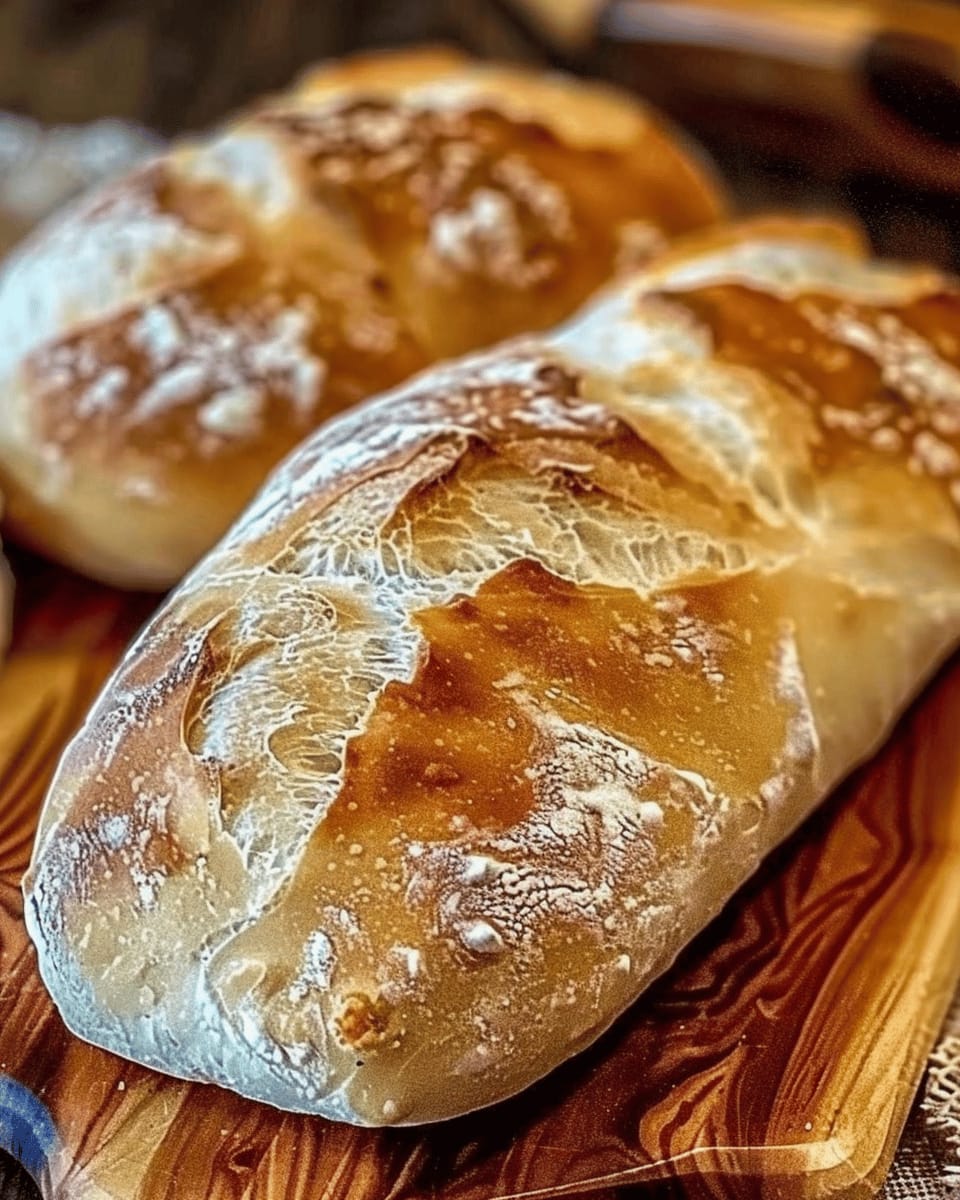Introduction
Ciabatta bread, characterized by its rustic appearance and airy crumb, is a quintessential Italian loaf that has found its place in kitchens around the world. This delightful bread has a chewy crust and a soft interior, making it perfect for sandwiches or enjoying with a drizzle of olive oil. This article presents a straightforward recipe for crafting this beloved bread at home, ensuring that every bite evokes the essence of Italy.
Detailed Ingredients with measures
Flour: 4 cups (500g)
Water: 1 and 1/2 cups (375ml)
Salt: 2 teaspoons
Yeast: 1 teaspoon
Olive oil: 1 tablespoon
Prep Time
Preparation for making ciabatta bread generally takes about 15 minutes. This includes mixing the ingredients and allowing the dough to rest before the first rise.
Cook Time, Total Time, Yield
Cook Time: 30 minutes
Total Time: Approximately 3 hours (including rising time)
Yield: 2 loaves
This simple yet rewarding ciabatta bread recipe invites bakers of all levels to experience the joy of homemade Italian bread. With careful attention to the dough’s handling and a dash of patience, you can bring this traditional loaf to your table, enhancing any meal with its delightful flavors and textures.
Detailed Directions and Instructions
Step 1: Prepare the Dough
In a mixing bowl, combine the flour, water, and yeast. Mix until a rough dough forms.
Step 2: Autolyse
Let the mixture rest for about 30 minutes. This allows the flour to hydrate and gluten to develop naturally.
Step 3: Add Salt
After the resting period, sprinkle salt over the dough. Mix it in using your hands or a dough scraper until fully incorporated.
Step 4: Knead the Dough
Perform stretch and fold techniques every 30 minutes for 2 to 3 hours. The dough should become more elastic and smoother.
Step 5: Bulk Fermentation
Cover the dough and let it rise at room temperature until it doubles in size, which may take about 2 to 4 hours, depending on the temperature.
Step 6: Pre-shape the Dough
Turn the dough out onto a floured surface. Divide it into two equal portions and gently pre-shape them into rectangles.
Step 7: Final Shaping
Once the dough has rested for 20 minutes, shape each piece into a loaf by stretching and folding the edges toward the center.
Step 8: Second Rise
Transfer the shaped loaves onto floured parchment paper. Cover them with a damp cloth and let them rise for another 1 to 2 hours until they are noticeably puffed.
Step 9: Preheat the Oven
While the dough is rising, preheat your oven to 450°F (230°C). Place a baking stone or an inverted baking sheet inside to warm.
Step 10: Score the Loaves
Just before baking, use a sharp knife or a lame to score the top of each loaf with a few slashes. This allows for proper expansion in the oven.
Step 11: Bake the Bread
Transfer the loaves onto the preheated stone or sheet. Bake for 20 to 25 minutes, until they are golden brown and sound hollow when tapped on the bottom.
Step 12: Cool the Bread
Let the bread cool on a wire rack before slicing. This ensures the inside remains tender and fluffy.
Notes
Tip for Flour
Use high-protein bread flour for the best results, as it helps develop gluten for a chewy texture.
Hydration Levels
This ciabatta dough has a high hydration level, so be prepared for a sticky dough. It is normal and contributes to the bread’s texture.
Storage Suggestions
Store the cooled bread in a paper bag at room temperature for up to 2 days. For longer storage, wrap in plastic wrap and freeze.
Serving Suggestions
Ciabatta bread is perfect for sandwiches or served alongside soups and salads. Enjoy fresh for the best flavor!
Cook techniques
Autolyse
The autolyse technique involves mixing the flour and water and letting it rest for a period. This helps to develop gluten and improves the dough’s extensibility.
Stretch and Fold
This technique is used during the bulk fermentation phase. By stretching and folding the dough, you enhance its strength and structure without kneading.
High Hydration Dough
Ciabatta requires a high amount of water in the dough, which creates a wetter and stickier consistency. This helps achieve the characteristic open crumb structure.
Pre-shaping
This step involves gently shaping the dough into a round or oval before the final shaping. It helps to relax the gluten and prepare for the final shape.
Baking with Steam
Introducing steam in the oven during the first part of baking promotes better oven spring and creates a crusty texture on the outer layer of the bread.
FAQ
What is ciabatta bread?
Ciabatta bread is a rustic Italian loaf known for its airy, open crumb and crispy crust.
Why is my ciabatta dough sticky?
Ciabatta dough has a high hydration level, which makes it stickier than traditional bread dough. This is normal for ciabatta.
How can I tell when my ciabatta is done baking?
Ciabatta is usually done when it has a deep golden-brown crust and sounds hollow when tapped on the bottom.
Can I freeze ciabatta bread?
Yes, ciabatta bread can be frozen. Wrap it tightly in plastic wrap and aluminum foil to preserve its freshness.
What can I serve with ciabatta bread?
Ciabatta pairs well with olive oil for dipping, sauces, soups, and can be used to make sandwiches.
Conclusion
The Italian Ciabatta Bread is a delightful addition to any meal, offering a crispy exterior and a soft, airy interior. Perfect for sandwiches, toasting, or as a side to your favorite dishes, this bread elevates your dining experience with its artisanal quality. With a bit of patience and the right technique, you can achieve a bakery-level loaf that impresses friends and family.
More recipes suggestions and combination
Bruschetta Topped with Tomatoes and Basil
Enjoy your ciabatta bread sliced and toasted, then topped with a mixture of fresh tomatoes, basil, garlic, and olive oil for a refreshing appetizer.
Ciabatta Sandwiches
Layer slices of ciabatta with your choice of meats, cheeses, and fresh vegetables to create delicious sandwiches perfect for lunch or picnics.
Garlic Bread with Herb Butter
Spread a mixture of softened butter, garlic, and herbs over sliced ciabatta and bake until golden brown for a flavorful side dish.
Ciabatta Panzanella Salad
Cube stale ciabatta and toss it with ripe tomatoes, cucumbers, red onions, and a vinaigrette to make a classic Tuscan salad that’s vibrant and satisfying.
Panini Pressed Ciabatta
Use your ciabatta to make hot paninis filled with your favorite cheeses and veggies, grilled until crispy and melty for a quick and delicious meal.


Leave a Reply